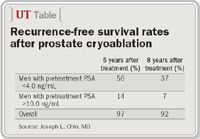Article
Salvage cryo after RT extends recurrence-free survival
Atlanta-Cryoablation is a feasible treatment option for patients who have failed radiotherapy, especially for those who may not be considered suitable candidates for salvage radical prostatectomy, according to a new study from Canada.

Researchers from the University of Western Ontario, London, assessed the feasibility and efficacy of cryoablation in 187 men who had failed definitive radiotherapy for prostate cancer. The patients had local recurrence of prostate cancer and no clinical evidence of distant metastases.
All patients underwent cryoablation using the Cryocare system (Endocare, Irvine, CA), and researchers studied the patients for a mean 39-month follow-up. The researchers chose cryoablation because it has been shown in preliminary studies to be cytocidal and has the theoretical advantage of being relatively noninvasive, said senior author Joseph L. Chin, MD, chair of surgical oncology and professor of urology and oncology.
According to Dr. Chin, the cryoablation procedure was well tolerated in the study, with 10% of patients experiencing mild to moderate incontinence and 2%, fistula formation.
Predictors of recurrence
Serum PSA and Gleason score at time of cryoablation were predictive factors for biochemical recurrence on univariable analysis. However, serum PSA was the only predictive factor of biochemical recurrence on multivariable analysis (p<.001).
"We found that, overall, the serum PSA level at the time of cryoablation was the best predictive factor for success with cryoablation, as defined by the biochemical recurrence-free survival rates," he said.
Patients with low PSA pre-cryoablation (<4.0 ng/mL) had a 5-year biochemical recurrence-free survival rate of 56% and an 8-year biochemical recurrence-free survival rate of 37%. In contrast, patients with high PSA (>10.0 ng/mL) had a 5-year biochemical recurrence-free survival rate of only 14% and an 8-year recurrence-free survival rate of 7%. Patients with PSA levels in the 4.0 ng/mL to 10.0 ng/mL range had an intermediate survival outcome.
Overall, survival rates for the entire group at 5 and 8 years were 97% and 92%, respectively. Researchers started hormone therapy on 32% of the entire cohort for post-cryoablation disease progression, defined as biochemical failure or clinically evident recurrent disease. The mean time for starting hormone therapy in these patients was 31 months after their cryoablation procedures, Dr. Chin said.
"In addition to the conclusion that cryoablation is a viable treatment option for patients who have failed radiation therapy, we found that the best candidates for salvage cryoablation appear to be those patients with low PSA levels: less than 4.0 ng/mL at the time of cryoablation," he explained. "Even for those who exhibited disease progression after cryoablation, the majority of those patients would have had the benefits of deferring the start of hormonal therapy for a meaningful time period."















